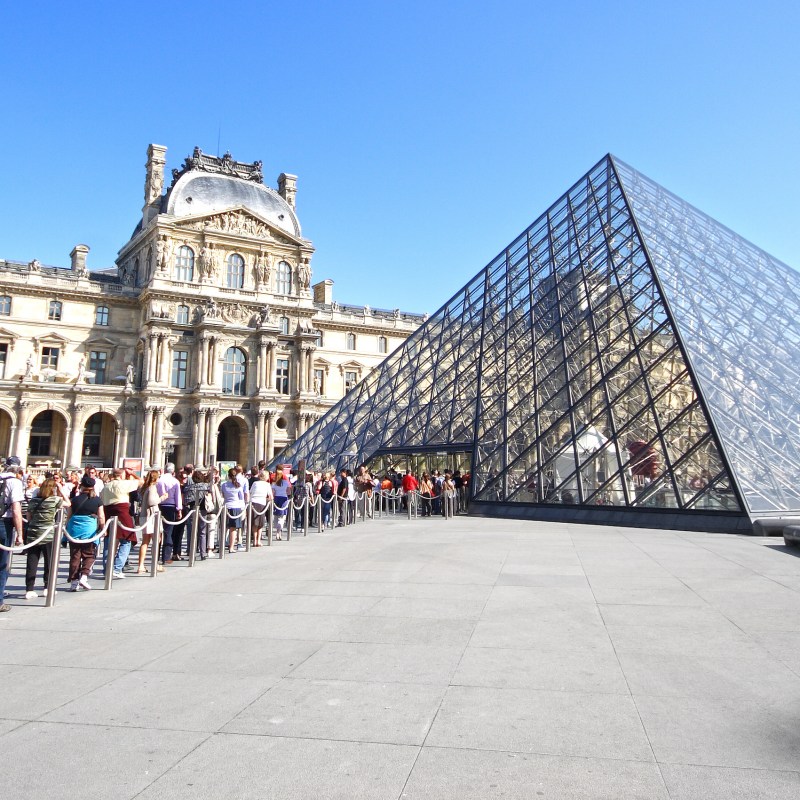
Paris is the most visited city in the world, attracting over 30 million people annually. The top attractions by number of visitors per year are:
Videos by TravelAwaits
- Disneyland Paris (12 million)
- The Louvre (10.5 million)
- The Eiffel Tower (7 million)
- The Palace of Versailles (5 million)
- The D’Orsay Museum (3 million)
These numbers can be daunting when planning to visit Paris and wanting to avoid crowds and long lines. Here’s a list of practical, time- and money-saving tips based on my experience as a Paris resident and tour guide that will make your visit to the top Paris sites more enjoyable.
1. Purchase Tickets Online In Advance
Just showing up at the Louvre or the Eiffel Tower, you can easily wait at least one to three hours during peak season, which is May to September. One sure way to avoid lines is to purchase your tickets online in advance. Most Paris attractions have websites, and you can purchase timed or day-specific tickets. If you google any of these Paris attractions, make sure you go to the official website, not a general purchase or third-party ticket site, such as Viator, because you will pay an additional service charge for your ticket. Once you arrive at the attraction, you will see signs for ticket holders. Note that even with advance tickets, there still could be a 30- to 45-minute wait at the Louvre and the Eiffel Tower.
2. Join A Guided Tour
Guided tours are an informative way to visit Paris museums and are also time saving. A guided tour of the Louvre is strongly recommended because it’s the world’s largest museum, with over 35,000 pieces of art on display. When you take a two- or three-hour highlights tour with a guide, you will see the most significant pieces in the Louvre including the Mona Lisa and the Venus de Milo, plus you will save time and energy walking and trying to figure out where things are, since your guide will know all the shortcuts in the museum. Another option at the Louvre is to rent an audio guide tour in advance when you purchase your ticket.

3. Visit During Off-Peak Hours
Almost every museum in Paris stays open late at least one day a week. The Louvre is open until 9:45 p.m. on Wednesdays and Fridays, and the D’Orsay is open until 9:45 p.m. on Thursdays, so if you book a ticket after 5 p.m., you will avoid the daytime crowds.
The Eiffel Tower is open until 12:45 a.m. from June 20 to August 29, and the rest of the year until 11:45 p.m. From May to August, sunset is between 9 p.m. and 10:15 p.m., so if you reserve your tickets after 7 p.m., you will still get to enjoy the views in full daylight.
Although the Palace of Versailles is only open until 6 p.m., the gardens are open until 8:30 p.m. from May until September. The palace visit takes between an hour and a half to two hours, so if you book your tickets after 3 p.m., you will avoid the bulk of the daytime crowds.
Disneyland Paris is open until 9:30 p.m. every day.
4. Book An Off-Peak Trip
Peak months for visiting Paris are May to August, mid-peak months are April, September, and October, and off-peak months are January, February, March, November, and December (except for the week before Christmas and the week in between Christmas and New Year’s, which are also busy).
Although Paris can be cold in winter, it rarely freezes, and in the height of winter, daytime temperatures average between 35 and 45 degrees Fahrenheit, with little or no snow. Airfare, hotels, and Airbnb and apartment rentals are approximately 30 percent less in the off-peak months than they are during peak months, and popular attractions have minimal crowds and wait times.
Certain American holidays or holiday weekends, such as Martin Luther King Jr. Day, Presidents Day, Memorial Day, the 4th of July, and Labor Day, are not holidays in France, so all attractions are open, and some of these holidays are during off-peak months. Thanksgiving is an ideal time to come to Paris since it’s not a holiday here. In fact, it’s one of the quietest times of the year for tourism, plus the Christmas holiday decorations and store windows are already on display. A number of Paris restaurants even serve a traditional Thanksgiving dinner.
5. Go To Alternative Sites
If you don’t want to deal with the popular, overcrowded tourist sites, here’s a list of alternate attractions that are similar and worth your consideration.

Instead Of The Eiffel Tower, Tour Montparnasse Or Arch De Triomphe
The Tour Montparnasse, an office tower, is the tallest building in Paris, at 59 stories, or 690 feet. It has an observation deck on the top floor with great panoramic views of Paris and beyond. Ticket prices are currently 18 euros instead of the 26 euros for the Eiffel Tower. Montparnasse Tower also has an excellent gourmet restaurant on the top floor, with prices that are about 50 percent less than you’d pay at the Jules Verne restaurant at the Eiffel Tower.
The top of the Arc de Triomphe, the historical, neoclassical arch commissioned by Napoleon in 1806, is another terrific place for views of Paris. Since the Arc de Triomphe is only 164 feet high, you get a much more detailed view and street plan of Paris than the aerial views from the Eiffel Tower allow.
Instead Of Disneyland Paris, France Miniature
In the same time it takes to get to Disneyland Paris from Paris (approximately 45 minutes), you can visit another fun, alternative wonderland. France Miniature features 160 outdoor, 1/30-scale models of major French monuments and landmarks including the Eiffel Tower, the Louvre, and Montmartre in Paris, plus impeccably detailed replicas of Saint-Tropez, Mont Saint-Michel, the French Alps, and the French Riviera. There’s also an amusement park, restaurants, and snack bars.
Instead Of The Louvre, The Petit Palais
A gorgeous example of beaux arts architecture, the Petit Palais was built as an exhibition space for the 1900 Paris World’s Fair. Today the Petit Palais is a city museum on two floors, and admission to the permanent collection — which consists of artworks from European and French artists from the medieval and Renaissance periods, extending to the 20th century — is free.

Instead Of The D’Orsay Museum, The Orangerie And The Marmottan
The D’Orsay Museum is known for its extensive collection of impressionist paintings, especially the works of Claude Monet, who began the impressionist movement in the mid-1800s.
The Orangerie in the Tuileries Garden displays a series of Monet’s last and most important paintings, the Water Lilies. Monet painted a series of eight massive paintings, measuring 300 feet in length, of his beloved water lilies from the Japanese garden at his home in Giverny. In the lower level of the museum is a good-sized collection of impressionist paintings by other artists. You can purchase a combined ticket for the D’Orsay and the Orangerie at a discounted price, and they are about 15 minutes walking distance from each other.
The largest collection of Monet paintings under one roof is at the Marmottan Museum, also in Paris. The mansion of a wealthy family in the late 1800s, the Marmottan was the beneficiary of a large collection of Monet paintings donated by one of the family’s sons, Michel, in 1966. The museum now contains over 100 Monet paintings that are on permanent display.
Instead Of Versailles, Fontainebleau
A little further outside of Paris than Versailles is another spectacular, historical royal palace: Fontainebleau. Located next to the second largest forest in France, once reserved for royalty to hunt, the Chateau Fontainebleau is just as grand as Versailles but not as well known or frequently visited. The chateau contains 1,500 rooms, many of them furnished, and over 300 acres of gardens. Headed to Fontainebleau? Here’s how to spend a day in the quaint village of Barbizon, France, which is less than 15 minutes away.
